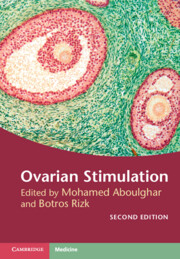Book contents
- Ovarian Stimulation
- Ovarian Stimulation
- Copyright page
- Dedication
- Contents
- Contributors
- About the Editors
- Foreword
- Preface to the first edition
- Preface to the second edition
- Section 1 Mild Forms of Ovarian Stimulation
- Section 2 Ovarian Hyperstimulation for IVF
- Section 3 Difficulties and Complications of Ovarian Stimulation and Implantation
- Chapter 12 Ovarian Stimulation in Difficult IVF Cases
- Chapter 13 Polycystic Ovary Syndrome: Ovulation Induction Strategies
- Chapter 14 Polycystic Ovary Syndrome: Controlled Ovarian Stimulation
- Chapter 15 Prevention of Ovarian Hyperstimulation Syndrome
- Chapter 16 Treatment of Ovarian Hyperstimulation Syndrome
- Chapter 17 How to Individualize Ovarian Stimulation Protocols to Avoid Difficulties and Complications
- Chapter 18 Endometrial Receptivity
- Chapter 19 Folliculogenesis and Implantation Failure
- Section 4 Non-conventional Forms Used during Ovarian Stimulation
- Section 5 Alternatives to Ovarian Hyperstimulation and Delayed Transfer
- Section 6 Procedures before, during, and after Ovarian Stimulation
- Index
- References
Chapter 13 - Polycystic Ovary Syndrome: Ovulation Induction Strategies
from Section 3 - Difficulties and Complications of Ovarian Stimulation and Implantation
Published online by Cambridge University Press: 14 April 2022
- Ovarian Stimulation
- Ovarian Stimulation
- Copyright page
- Dedication
- Contents
- Contributors
- About the Editors
- Foreword
- Preface to the first edition
- Preface to the second edition
- Section 1 Mild Forms of Ovarian Stimulation
- Section 2 Ovarian Hyperstimulation for IVF
- Section 3 Difficulties and Complications of Ovarian Stimulation and Implantation
- Chapter 12 Ovarian Stimulation in Difficult IVF Cases
- Chapter 13 Polycystic Ovary Syndrome: Ovulation Induction Strategies
- Chapter 14 Polycystic Ovary Syndrome: Controlled Ovarian Stimulation
- Chapter 15 Prevention of Ovarian Hyperstimulation Syndrome
- Chapter 16 Treatment of Ovarian Hyperstimulation Syndrome
- Chapter 17 How to Individualize Ovarian Stimulation Protocols to Avoid Difficulties and Complications
- Chapter 18 Endometrial Receptivity
- Chapter 19 Folliculogenesis and Implantation Failure
- Section 4 Non-conventional Forms Used during Ovarian Stimulation
- Section 5 Alternatives to Ovarian Hyperstimulation and Delayed Transfer
- Section 6 Procedures before, during, and after Ovarian Stimulation
- Index
- References
Summary
Polycystic ovarian syndrome (PCOS) is one of the most prevalent endocrinopathies affecting 5 to 10 percent of women of reproductive age [1;2]. Characteristic clinical features of PCOS include menstrual irregularity such as oligomenorrhea/amenorrhea and signs of hyperandrogenemia including hirsutism, acne, and/or obesity. The syndrome was first clearly described by Stein and Leventhal in 1935 [3]. While the primary etiology remains poorly defined [4], insulin resistance with compensatory hyperinsulinemia is a prominent feature of the condition and appears to be an underlying cause of hyperandrogenemia identified in both lean and obese women [5]. Hyperinsulinemia promotes increased ovarian androgen biosynthesis in vivo and in vitro [6;7]. It also decreases sex hormone-binding globulin production in the liver [8], which results in the increased bioavailability of free androgens and exacerbates the signs of androgen excess.
- Type
- Chapter
- Information
- Ovarian Stimulation , pp. 119 - 131Publisher: Cambridge University PressPrint publication year: 2022



